When rewatching old artist talks of AO Roberts in preparation for our conversations I came across a quote of theirs “I have so much to say but I don’t want to tell you anything at all.” There's a tension within Roberts’ work between revealing and obscuring, a generosity to the viewer as well as a distrust. AO Roberts is a Winnipeg-based multidisciplinary artist working in sculptural installation and sound. They have also performed in numerous noise projects and punk bands such as Wolbachia, Kursk, Hoover Death, and VOR. During the winter of 2022, I chatted with Roberts several times on Zoom, myself in Toronto, and Roberts in Winnipeg. Throughout these conversations, we touched on many of the diverging threads in Roberts’ work: medieval histories, anti-capitalist frameworks, chronic illness, and the tactile and sonic qualities of language.
While home for the holidays that same winter, my mom and I visited Roberts’ most recent solo exhibition, Sickroom (2022), at the School of Art Gallery at the University of Manitoba. I have been a fan of Roberts (both them and their work) for a long time, but even with these high expectations, the work overwhelmed me. The exhibition so brilliantly materialized ideas from my own recent readings on critical disability theory, while at the same time making unexpected and poetic connections between themes of property, protection, body, care, and control.
While Roberts’ work is sonically and visually enamouring, perhaps most striking is the way their works weave together tangential threads of exploration into cohesive artworks. These creations simultaneously anchor the research and allow the viewer to be drawn in diverse directions by myriad strands of thought. Roberts shared that “about .001 % [of their research] ends up in a room in where people can actually look at it and talk about it.” In our conversations, I was eager to delve into their distinct approach to research, to deepen my understanding of their prolific practice as a significant mid-career artist based in Winnipeg.

Sickroom. Install at University of Manitoba School of Art Gallery. 2022. To view installation go to: https://vimeo.com/795750930

Sickroom. Install at University of Manitoba School of Art Gallery. 2022. To view installation go to: https://vimeo.com/795750930

Sickroom. Install with view of Void Verse #1 (Diagnosis) and Void Verse #2 (Cure/Curse). Sand cast iron, thermoset polymer, spruce. Dimensions variable. 2022.
Upon entering The School of Art Gallery, I was greeted by a sizable excision of a wrought iron fence, a particularly poignant feature of the show. The iron is shaped to illustrate letters that metamorphose from “CURES” to “CURSE.” In this piece Roberts, living with chronic illness, reckons with the simultaneous grief and power that comes with disability, referencing activist Eli Clare’s book Brilliant Imperfection: Grappling with Cure (2017) as inspiration. The words CURSE/CURES serve as a powerful entry point to the exhibition. This simple play on words conceptually expands far beyond the five letters to evoke the body, diagnosis, medicine, healing, chronic illness, disability, joy, pain, power, pride, language as malediction, and blame. This piece acts as a conceptual gateway, contextualizing the rest of the exhibition. A second work, similarly constructed of metal and wood, plays with the legibility and abstraction of the word “Diagnosis,” set repetitively in the form of a fence or room divider. These twin sculptures use the material form of the wrought iron fence to evoke concepts of boundaries and property. In the exhibition text, curator Blair Fornwald writes that the works “reveal the magical thinking that reinforces the permeable, indistinct, and ultimately temporary boundaries between chaos and order, between sickness and health, and between what is yours, [and] what is mine."1 Sickroom examines sites of supposed “healing” such as spas, sanatoriums, and palatial estates, exploring how the language of health is co-opted for profit by the real estate industry.
In the center of the gallery stood a skeletal wood structure which resembled a bandstand. Discussing their use of this form Roberts explains:
“[The] structure itself is a part of the history of the enclosure movement in England and a lack of common space and the enclosure of farmlands. Before people would just go in the country and hang out at the tavern or the pub and play instruments, it was spontaneous and with the lack of public space it became public parks and bandstands and music on Sundays only, and then that became this focal point for peoples natural need for socialization and culture and music… So to me, it was kind of this natural choice to choose this structure that was a part of the early days of capitalism and land ownership and where sound was emanating from ritually...”
Centered within the bandstand platform, Roberts has installed a sound piece. Aluminum pipes are arranged in a spaced-out circular formation. Speakers contained within each pipe, create distinct feedback loops with the mixing board. As you move around the pipes, the sound changes, giving the impression that it is responding to your movement within the space. In reality, Roberts is crafting an auditory hallucination inspired by the droning sounds of medical and healing spaces, such as MRIs and sound baths. While enveloped by the work, the wavelengths felt deeply unsettling, a similar claustrophobic feeling to having an MRI. This piece brought up the traumas associated with spaces and processes of healing, sensations vividly recalled in both my body and my mother’s as we encountered this work. The installation links the physical sensation of medical trauma to the histories of land ownership, public commons, and the annexation of the natural world. The skeletal bandstand (lacking a roof or walls) symbolizes these narratives while failing to fulfill its intended purpose of providing shelter from anything at all.
Adorning the walls of the gallery are small, textual designs laser cut from coloured acrylic, and affixed perpendicular to the walls. Similar to the larger sculptures, these small pieces play with the readability of one word slowly morphing into another, or distorting from a legible to illegible design: “ bitter/breeze,” “rotten/hum,” “ocean/views,” and “serene/envy.” These works are minimal in presence, shimmering at the edges of the gallery, with a contorting sense of confusion and clarity and a dark nod towards humour. A smaller piece, inspired by the mystical qualities of amulets or talismans, forged in a fold-out shape reads “fresh air high ceilings.” For these smaller text-based works, Roberts sifted through real estate ads and website tags (which are added to attract more site traffic). In our conversations, Roberts brought up the advertising term “the pain funnel,” a sales technique designed to uncover a potential buyer's “pain points,” so that sellers can exploit that weakness to encourage consumption of their product. This was a truly dystopian term that was new to me, but with a quick Google search, it became clear that this term is common in the marketing sector. There is a desire inherent within the search for a cure, for a diagnosis, an explanation, a root cause. One searches for relief, and capitalism preys on that. Within their work, Roberts looks at the “real estate of desire and healing,” exploring how the industry sells a portal to a future of health and privilege. Roberts shares that, “the impulse of hope is necessary to survive, we need to make meaning, but the part I am most interested in today is where our desire is dug out via capitalism and the way healing can be presented as something you can acquire.” Sickroom evocatively showcases Robert’s unique explorations into the tactility of language and the sculptural qualities of sound. Thematically, the work delves into personal and societal perceptions of illness, health, healing, and care. These themes, poignantly showcased, echo throughout AO Roberts’ vast body of work which has been carefully crafted over the past decade.
To back up a few years, my circles first started to intersect with Roberts in 2011 when they co-founded ngtvspc, an anti-capitalist, feminist art collective and venue based in Winnipeg.2 However, Roberts’ journey began long before our paths crossed. They grew up between Alberta and Saskatchewan, raised in a working-class family. Watching their parents work tirelessly in the service industry provided Roberts with an intimate lens into class and labour, shaping their politics as feminist and anti-capitalist from a young age. With both parents working long hours, Roberts and their brother were often left to their own devices. As a self-described “typical Gen X Latchkey kid,” they had the freedom and necessity to creatively pass the time by making wacky art from a young age. Later, as a young adult in the 1990s, Roberts ended up in Vancouver doing frontline harm reduction work in the Downtown Eastside during the day and playing in punk bands by night. The Vancouver punk scene which Roberts was a part of was a politically charged subculture and a space where activism and art were inextricably connected. Roberts’ time in Vancouver was formative for the anti-capitalist politics that are embedded within every aspect of their life and art practice. When Roberts decided to leave Vancouver it was the early 2000’s and they wanted to get out. They settled on Winnipeg through a process of elimination, and other than a few interludes for grad school (at the California College of the Arts, in San Francisco) and residencies, Roberts has resided there since.
As mentioned, in the early 2010s, Roberts co-founded ngtvspc in Winnipeg alongside Shelagh Pizey-Allen, Caitlin Hutchison, and Doreen Girard. The project was initiated to address the lack of exhibition and venue space they witnessed within the city. Located at the boundary between Chinatown and The Exchange District, ngtvspc hosted artists’ studios, jam spaces, a gallery, and regular performances, in particular punk and sound art shows. ngtvspc is remembered as a special spot in the city, a versatile space that transcended the barriers many typical art galleries have. I went to my first punk show there and was also included in my first gallery art show. Even though I viewed myself as somewhat of an outsider in the ngtvspc community, its impacts reverberate deeply in the ways I think about art and community. When I spoke with Cam Scott, the Artistic Director of send +receive (a sound art festival in Winnipeg) and friend and colleague of Roberts, he described how the project bridged a relationship between visual art and sound art/ noise projects that wasn’t always as strong in the city as it currently is. Scott went on to share that:
“ngtvspc was so generative for this whole microgeneration of artists, based in this super DIY ethos that had a lot more to do with some of the collective members’ participation in the punk scene for the 10 years preceding than their institutional education or affiliations.”
During this time, Roberts co-founded the sound series “Dah-Dit-Dah.” The project was designed to attract first time performers who had been tinkering at home. The results were playful and experimental events which activated a growing community. Scott credits these nights as launching some of the most compelling practices in the sound/noise scene in Winnipeg today.
When I discussed the legacy of ngtvspc with Roberts, they shared that their reflections on the space are always changing, and in hindsight, they recognize some problems with what they were doing. This self-criticality is evident in a 2013 artist talk by ngtvspc collective members at aceartinc. (Roberts was no longer a part of the space at this point), where they discuss how what was intended as an anti-capitalist project ended up replicating the problematic power relations of capitalism. Despite their intentions, collective members concede the space facilitated the exploitation of volunteer labour for cultural capital, privileged Whiteness, and contributed to gentrification. These reflections are essential to consider, however, there is no denying that ngtvspc made crucial contributions to the Winnipeg music and art scene during the brief two years they were open. The legacy of their organizing continues to inspire artists and art workers in the city to this day.
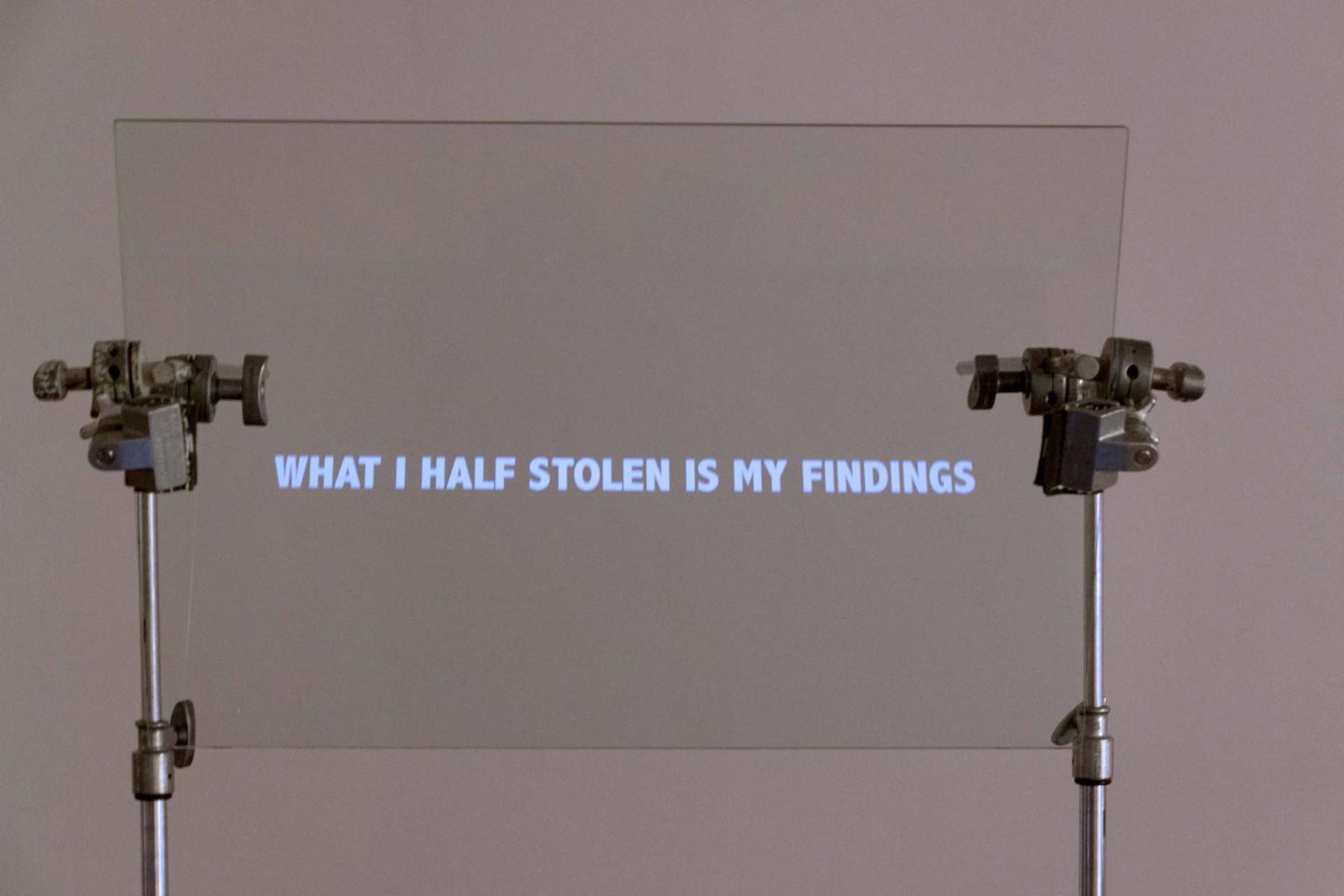
'The Yolk of Menial Light' at aceartinc. 2015, Installation view

'The Yolk of Menial Light' at aceartinc. 2015, Installation view
After becoming familiar with Roberts through ngtvspc, I first had the opportunity to spend focused time with their art practice at The Yolk of Menial Light, a solo exhibition held at aceartinc, in Winnipeg, in 2015. Bringing together sculptural and sound works to create an intermedia installation, the exhibition took over the large and sprawling gallery space. Akin to Sickroom, a throughline within this exhibition is illness and processes of healing. While Sickroom juxtaposes explorations of healing with real estate and landscape architecture, this exhibition looks at self-help culture and Eye Movement Desensitization and Reprocessing (EMDR). EMDR is a heavily contested form of psychotherapy treatment that encourages patients to focus on a traumatic event or memory in brief sequential doses while focusing on external bilateral stimulation, for instance, therapist-directed eye movements, or auditory stimulation. In The Yolk of Menial Light Roberts attempts to construct EMDR in three dimensions using sound from subwoofers to create auditory simulations of visual moirés. The two tones used are just above the human range of hearing, and together, produce a throbbing sound. In an artist talk from 2015, Roberts notes that their attempt to construct EMDR in three dimensions was a constructed failure that likely isn’t healing but instead, “captures the aesthetic and cacophony of capitalism.”
Moving through the dimly lit exhibition space, you come across discrete installations set up as theatre sets, each activated by the viewer as an unwitting actor. One such installation, titled I Dialect, is a sculptural makeshift teleprompter which enlists the unassuming viewer into the role of public apologist delivering a speech. The text is borrowed from public apologies delivered by various figures: Tiger Woods, Reese Witherspoon, and the CEOs of BP Oil and Goldman Sachs. Snippets from these apologies are combined into a single text, read aloud by Roberts and transcribed using dictation software (including mistakes), edited into configurations resembling intertitles, and presented to the viewer as their own speech notes.
Roberts often appropriates language from unique sources, transforming the text beyond its original form. This approach, common in their practice, highlights the fluidity of language, as words shed their original context and acquire new meanings. Did these speeches ever have meaning? In this case, what we are left with is a poetic and disconcerting text that suggests an apology, but raises more questions than it answers: what are you apologizing for? What are the motivations for the apology? Are you really sorry? Placed into this role (as I was), you simultaneously deliver the apology, while also attempting to decipher its meaning.
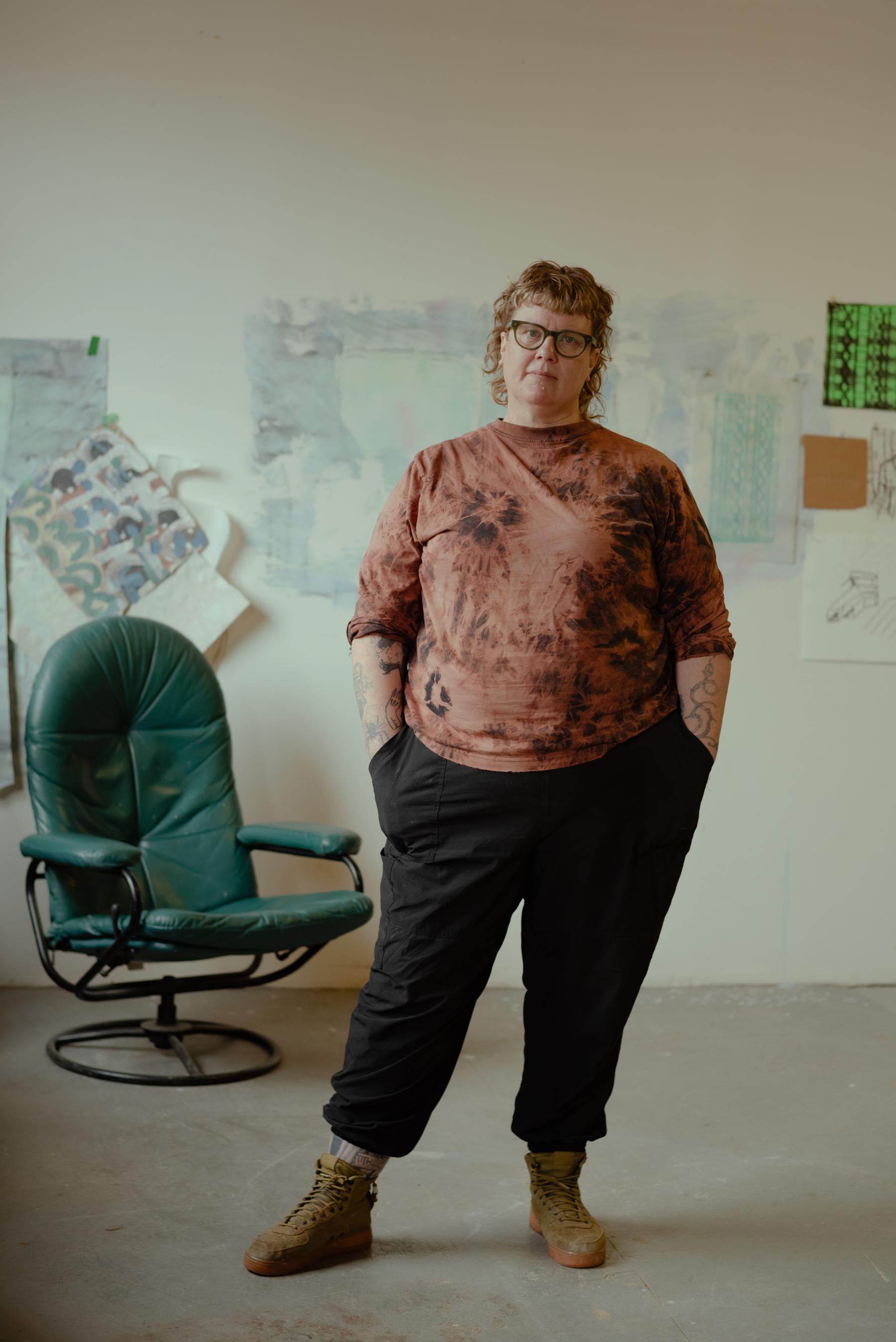
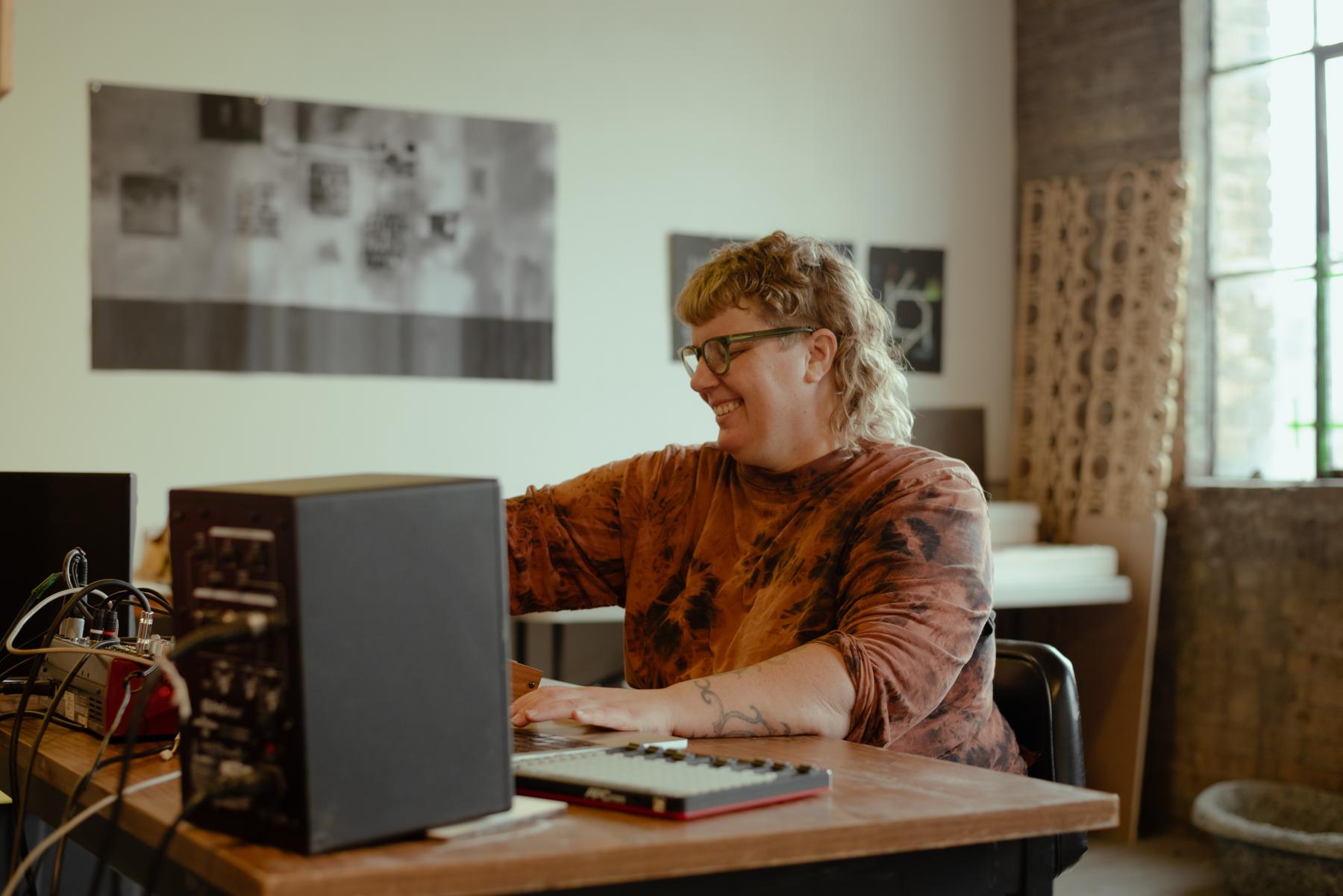
Photo by Ally Gonzalo
An apology is a speech act, the idea that speaking something aloud can create or alter. Roberts explains that it is a “performative utterance, a magical act of some kind and in apologizing they create something new, I love this form of speech act, it's like a vow or an oath” adding, “It's mostly disingenuous, you don't actually believe they are sorry.” This thread of magical speech connects to Roberts’ fascination with self-help books. Growing up, their family bookshelf contained a book called You Can Heal Your Life (Louise Hay, 1984) which details how negative thought patterns create experiences of illness, including cancer, AIDS, and even fatness. The book espoused an incredibly fraught and ableist perspective that blames the individual for their own illness or disability. The book then offers affirmations to oppose these thoughts and thus supposedly cure oneself. Connecting the societal obsession with self-help to neoliberalism, Roberts cites that “the more we are looking in and trying to solve our individual problems, the more we can’t see the systemic issues of violence or oppression that are around us.. [self-help] is full of magic and untruths and charlatans and people that just make up belief systems.” For Roberts, this is the most interesting part. Growing up, Roberts’ family experienced their share of physical and mental illness. Through books like this, their family came to advocate for fringe medical beliefs that Roberts traces back to the “conservative faith healing realm.” In The Yolk of Menial Light, they take a cynical stance against these practices. Reflecting on this work now, Roberts explains that in hindsight, and with their own experience with illness and disability, they now consider these beliefs with less judgment and more nuance. “While they acknowledge the harm, they also have a deep understanding of the pain that drives this search for relief, and as with Sickroom are more interested in looking at how these innate desires are exploited via capitalist logic.
Throughout our conversations, Roberts and I talked extensively about the way they think through both textual and sound-based language within their work. They often select words based on the way they sound or by their affect. As Scott describes, Roberts looks at “commodified instances of speech” transforming them until they are “jammed or corrupted.” Words become a malleable source material through which Roberts probes every aspect of their meaning, both in physical form and their semantic purposes. Roberts mentions that they consider “the individual word and all the individual resonances it has… how it looks, how it sounds when you say it when you think it, words have all these multi-layered presentations in our life...” In Critical Fictions, a recent text by writer and artist Hannah Godfrey which considers the practices of five queer prairie-based artists, including Roberts, the author describes this process as one that “transform[s] understanding by parsing language to its bones.”3 This complete interrogation and deconstruction of language is evident throughout each and every one of Roberts’ bodies of work.
One textual sculpture reads “TOTAL INSOLVENCY,” the phrase adopted from a store Roberts encountered that was going out of business. This text stood out to them because of its invocation of spirituality, and its seemingly total condemnation of character. Once again, Roberts references the aesthetics of capitalism while illustrating its failures. In Critical Fictions, Godfrey points out that this work showcases the “intertwining of humiliations, economics and morality.”4 Another sculpture reads “SIGH GASP HISS RALE” the words stacked on top of each other and delicately lasered into black fabric. This work alludes to the exhibition’s title, the root of the word stridents is stridor, a death rale if you are on your last breath. Godfrey elaborates that “these four letter words name activities intimately associated with breath and body, covering the gamut of aggression, sickness, and pleasure.”5
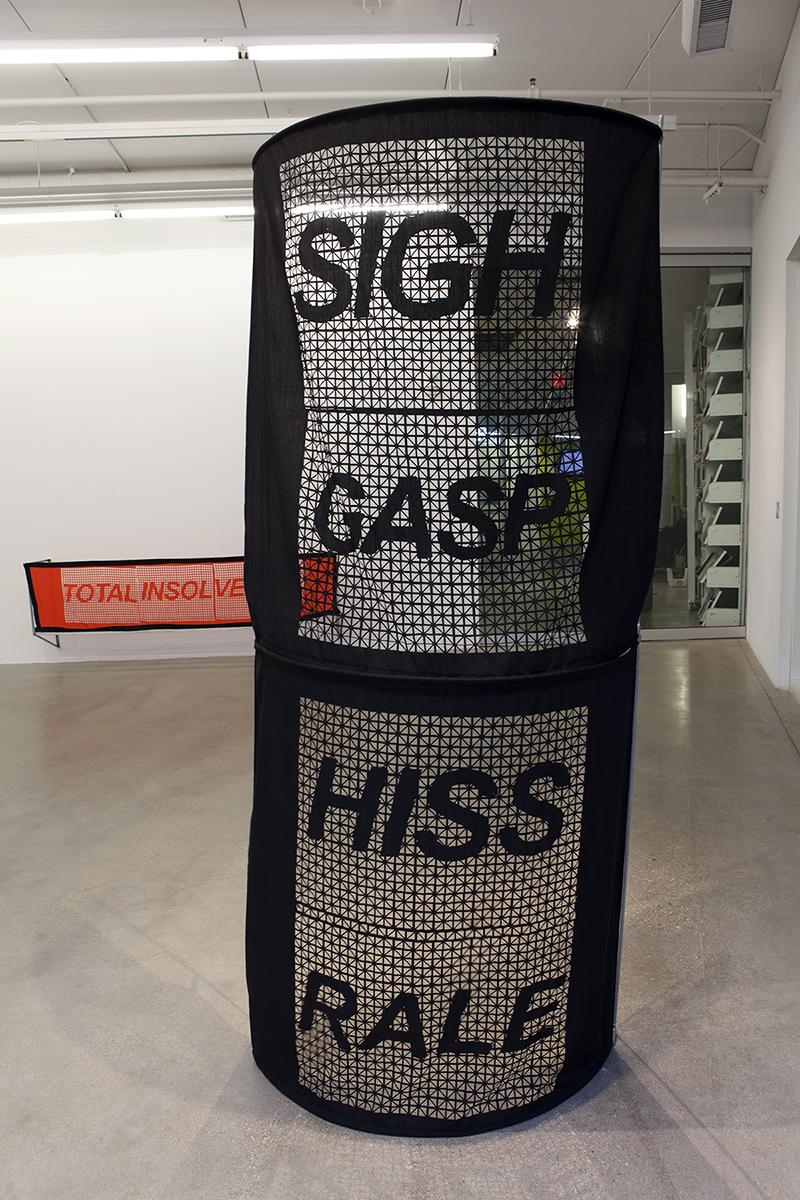
The Stridents #1(sigh gasp), #2 (total insolvency), #3 (there is gold dust). Cotton nylon, steel. Dimensions variable, 2016.
A sound work, Mirror for Recluses, emanates from concealed speakers. The speakers are installed behind plastic vents mounted in the middle of the wall on either side of a concrete bench. A contemporary feature of any building, the vents are easily overlooked. The sound emanating towards the viewer makes one pause, observing how the sounds pass through the grate, mirroring the aural permeability of the anchorite cells. As Godfrey notes in her text, are you, as the viewer, listening from inside, or are you outside the cell, one does not know.6 According to the artist’s website, the sounds are “polyvocal incantations of Speculum Inclusorum,” an instructional guide for anchorite life, which Roberts has edited to emphasize the sibilant (hissing) sounds within the speech, rendering the individual words incomprehensible. The effect is both incantatory and off-putting. In a 2017 review Kendra Place writes “Rather than creating a space for religious devotion, The Stridents draws these minor, material histories (of women, of outcasts) from European metanarratives to trace feminist, trans, and queer archaeologies of reclusion, retreat, or refusal.”7 Throughout Roberts’ practice, you can find a recurring invocation of medieval histories and early technologies, systems, and religious practices. Roberts spoke of this inclination towards the Medieval ages during our conversation:
“There are a lot of parallels between what is going on… not only economically and politically with chaotic times and with plagues but also with religious and spiritual yearning, there were all these movements in those times that were hermetic movements before Christianity was the colonial power that it is today, there was still a lot of pagan holdover within Christianity and that fusion of ritual and daily life was still really present…I am always trying to figure out what our folk rituals are today that have to do with capitalism.”
In 2019, Roberts created Crisis Canon, a site-specific intervention and performance curated by Jenifer Paparao as part of the second iteration of Plug In ICA’s STAGES Biennial. Roberts’ piece is a sand-blasted text intervention on a pre-existing large concrete block. The monolith-esque engraved sculpture is located just outside the city of Winnipeg. To access the work, you need the exact coordinates which will take you from a highway, to a gravel road and down a small dirt path to an open meadow. I went to find the sculpture outside of a scheduled performance or tour, feeling like both a trespasser and a kid on a treasure hunt. The installation site is an abandoned industrial waste site of a British-American cement plant, where they used the land to test the strength of their cement by pile-driving columns of concrete into the ground.8 In our conversations, Roberts describes the location of Crisis Canon as a site of “corporate colonial expansion..an insertion into the landscape” where they “tested how much the land could [withstand] year after year.” Following the damage inflicted on the land, Roberts wished to activate the space without causing further harm to the earth. Visiting the site, it was not immediately clear what was part of the work versus the preexisting construction interference. Large piles of concrete jutted out from the ground at varying heights, an art installation in their own right. The space is truly incredible, resembling a cross between an ancient ruin and a futuristic building site. I wondered how I could have lived in Winnipeg my whole life and not known this place existed. Roberts describes the post-industrial lot as an unbuilt space that provides a gateway towards a lost past or an alternate future, “a possible portal to a reality that isn't colonial capitalism, isn't racial capitalism…”
The large concrete block that has been recontextualized as Roberts’ installation, sits apart from the other concrete piles. The text on the sculpture reads “Let it be sorrow let us pursue it” repeatedly around the three-dimensional form. The text comes from Lorem Ipsum, commonly used as a placeholder text in layout and graphic design. Through their research, Roberts traced the origins of Lorem Ipsum back to a Roman rhetorician Cicero in the 1st century BCE. The original text explores the concept of hedonism, questioning whether we live life to avoid pain or access pleasure. The text has been mistranslated and used for centuries as a design tool, with the average user having no knowledge of the original meaning. Roberts describes the Lorem Ipsum placeholder as a “capitalist unconscious, that's flickering at the side of our eyes, questioning what are the philosophical choices that we make every day?” With a wry sarcasm in their voice, Roberts continues “But no, let's not think about it, let's leave it in Latin.” It's fascinating to think through how meaning is made and unmade in translation and appropriation. Despite the ubiquity of Lorem Ipsum, its origins remain unknown to many.
As part of Crisis Canon, Roberts further activated the landscape through a sound performance featuring vocalists Sarah Jo Kirsch, Zohreh Gervais, and sound artists Bret Parenteau and Doreen Girard. The sound work is a 5-piece score that uses the musical device of the canon. Watching the video documentation of the piece, the sun slowly sets across the landscape and the performers’ faces, and shadows elongate as the performance progresses. The inspiration for Crisis Canon came from “The Internationale,” a communist anthem, and the Coca-Cola jingle “I’d Like to Teach the World to Sing (In Perfect Harmony).” Both songs offer different versions of utopia. Altered by the vocalists, these songs turn from rousing melodies to mournful lamentations.
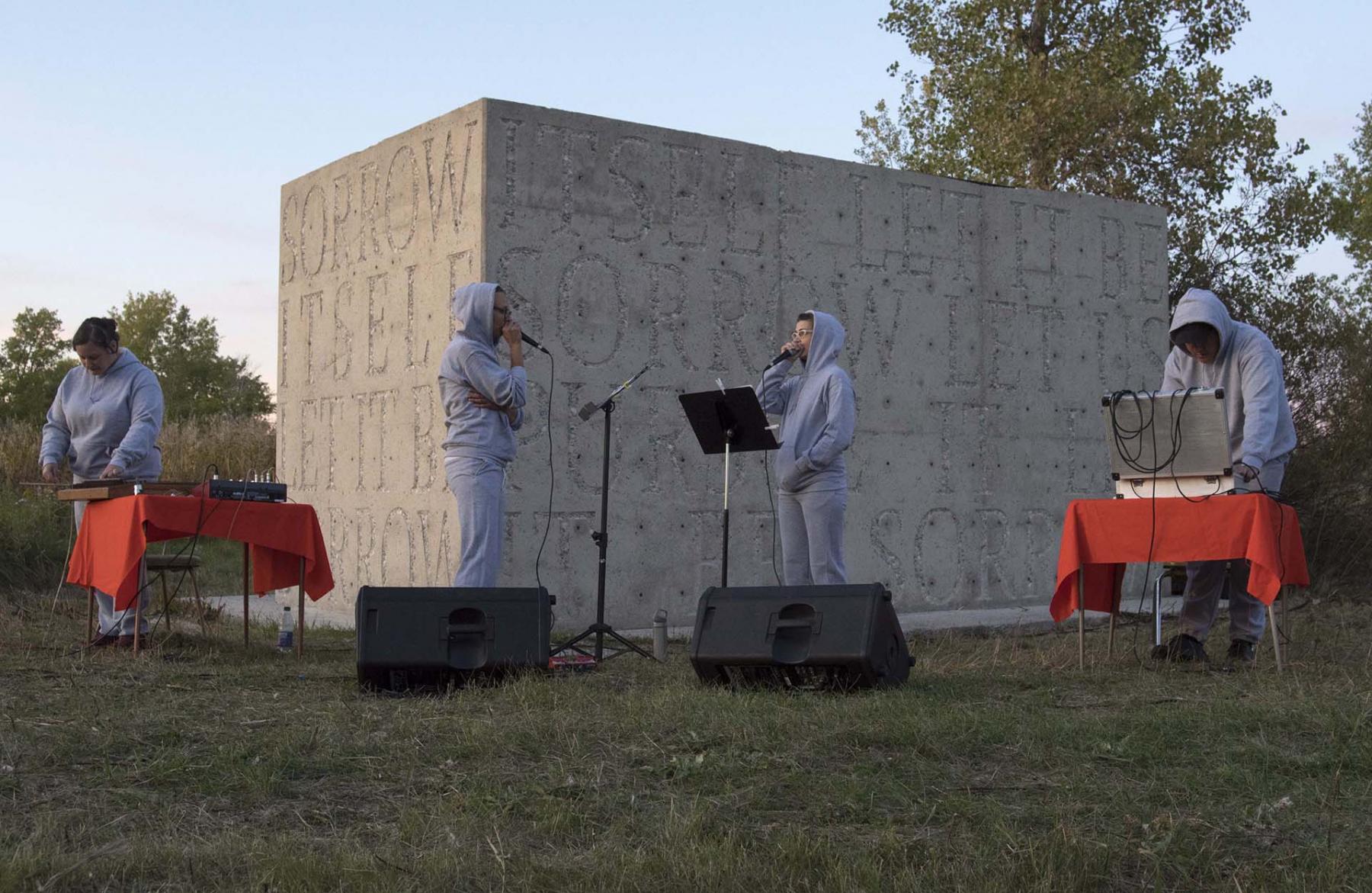
Crisis Canon (performance). Sandblasted text, site specific intervention and performance score, 2019. Performance five part score featuring two. Doreen Girard (prepared tsymbaly), Bret Parentau (electronics), Sarah Jo Kirsch (soprano), and Zohreh Gervais (soprano). View video documentation of performance go to: https://vimeo.com/525050033
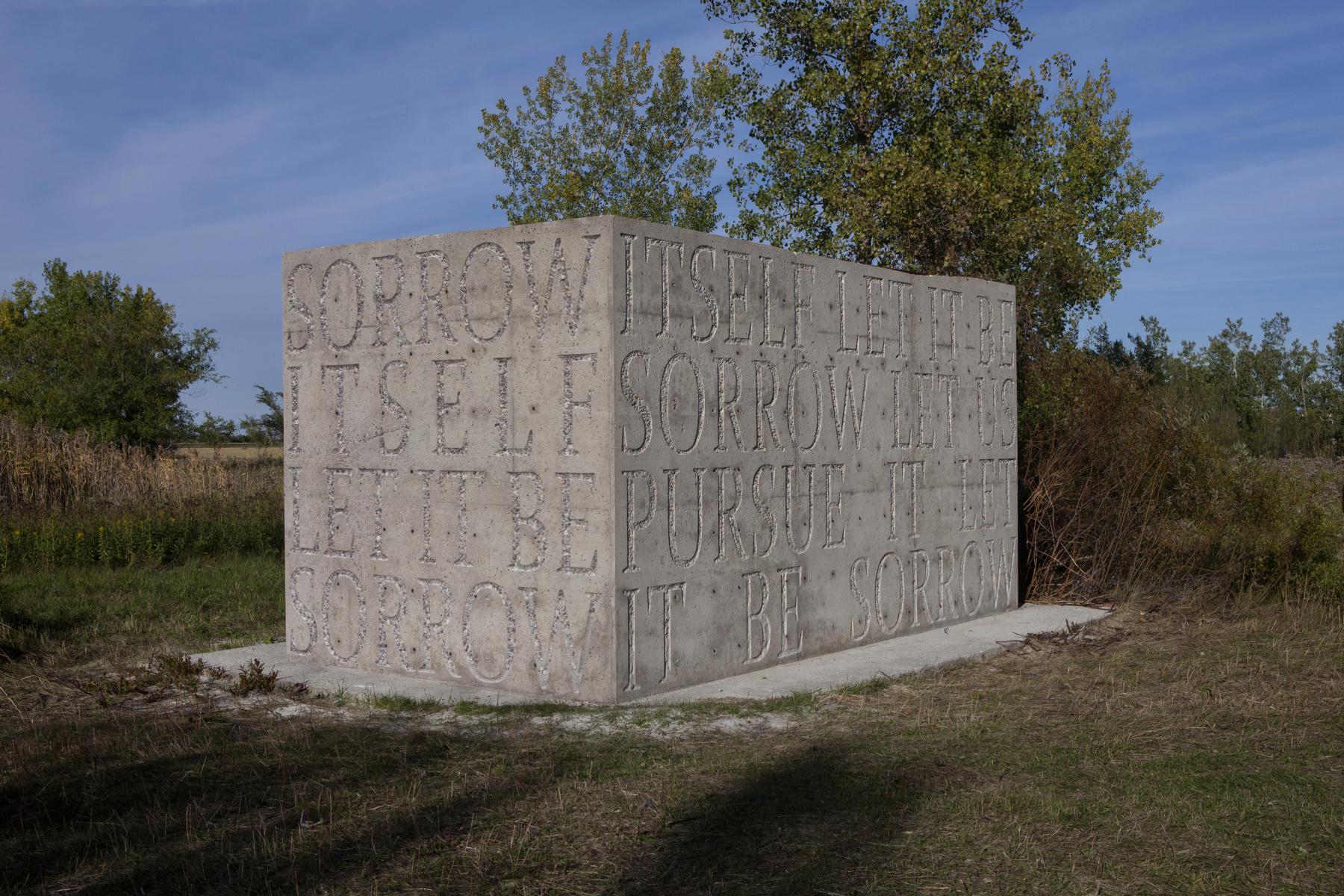
Crisis Canon. Site specific intervention, sandblasting, sound score and performance on a former test pile site of the British-American Concrete company in Winnipeg, Canada. Stages Biennial Plug In ICA. 2019.
During our conversations, Roberts often spoke about their fraught relationship with the idea of the viewer, and their curiosity in the logic of viewership. This is apparent in TheYolk of Menial Light, where they cast the viewer in the position of public orator. In other cases, this distrust emerges in the form of withholding. Roberts is very careful to share only so much, only a little of their personal narrative, and is sparing in the way research is revealed. They elucidate this relationship further:
“I don’t view the audience as a source of empathy, I don’t trust the dynamics of catharsis or confessional, I wish in a sense that a catharsis could work, do this thing and feel repaired…express this energy and put it on to others to deal with. I don't think that this works, I don't think of my experience as a burden but I also don’t want to transfer energy that can be experienced as a burden. I feel like everything I have done for a long time has been about questioning that relationship about what we think of as empathy and also what our positions are as artists. I’m not going to assume that I or anyone is positioned to receive care or receive empathy, all of our positions are so complicated, in a way of trying to withhold I am trying to keep that as a problem instead of ignoring it. How do you communicate the very personal aspect of your experience in a way that doesn’t do more harm...”
When discussing this with Roberts it is clear that this withholding is not a form of pretension or distrust, but consideration for the viewer. At every phase of Roberts' process, they take great care in considering the viewer. This is evident in their meticulous approach to research and creation, and it shines through in their relationship to the audience.
When I asked Scott about the importance of Roberts’ practice he shared an observation that while “so much comparable work is abject, Roberts’ work is reparative.” I found it enlightening thinking about that notion of repair over abjection as I moved through Roberts’ work. Throughout my research for this piece, I came across a quote of Roberts in a 2015 artist talk at aceartinc: “I have my own anxieties and ambivalences about making art and whether it's useful to begin with.” This summarized the existential anxieties that many artists (myself included) often feel in these times. During our conversation in February, I asked Roberts the big, perhaps cheesy, question: “Why do you continue to make art?” Imagining a similar tone of ambivalence, I was surprised and encouraged by Roberts’ more optimistic response:
“After the pandemic, I really realized how important art is to our lives, that we need to experience things together, especially art, especially sound...I really miss getting together with people and having events happen, I think about all the little shows that we put on for each other, we put on little shows for each other, that's what the basis of art is, sitting together and having one person showing off their feathers, and maybe those feathers are fucked up and like twisted from trauma and capitalism but maybe they’re still our feathers, and we can still do that.”
Shortly after Roberts’ exhibition Sickroom, they held a sale of a small set of their amulets, collectively titled POWER WORDS FOR EMOTIONAL COPY. These small necklace-like artworks, emulated the text sculptures from their recent exhibition, each containing a repeating word found in real estate and/or spiritual capitalism. I ordered one, and it hangs now on a small silver nail beside my window. I gaze over my computer at it as I write this. Coated in velvety green flocking, the piece reads “abundance, abundance, abundance, abundance, abundance,” the single word overlaid on top of itself until it is barely legible. An abundance of abundance. A confusion of abundance. I Google “abundance + real estate,” and a long list of real estate firms containing the word fills my screen ( Abundance Realty Group, Abundance Real Estate…). I scroll by an article titled “8 tips for cultivating a mindset of abundance in real estate.” In late capitalism who does abundance exist for really? Does channelling a spirit of abundance challenge a scarcity mindset? Does this lead to abundance for all? Or abundance for a few?
In folkloric or pagan traditions an amulet is an object worn for protection, or to bring good fortune. Roberts positions these amulets as a last-ditch effort for healing. Instilled with a hope that is a necessary impulse for survival. I’ll leave you with these images of ABUNDANCE that bind together all the criticality, desire, and hope that is deeply tied up in the profound practice of AO Roberts.